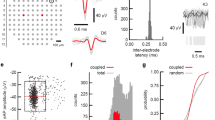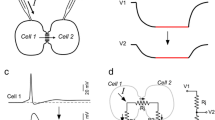Abstract
Electrical synapses continuously transfer signals bi-directionally from one cell to another, directly or indirectly via intermediate cells. Electrical synapses are common in many brain structures such as the inferior olive, the subcoeruleus nucleus and the neocortex, between neurons and between glial cells. In the cortex, interneurons have been shown to be electrically coupled and proposed to participate in large, continuous cortical syncytia, as opposed to smaller spatial domains of electrically coupled cells. However, to explore the significance of these findings it is imperative to map the electrical synaptic microcircuits, in analogy with in vitro studies on monosynaptic and disynaptic chemical coupling. Since “walking” from cell to cell over large distances with a glass pipette is challenging, microinjection of (fluorescent) dyes diffusing through gap-junctions remains so far the only method available to decipher such microcircuits even though technical limitations exist. Based on circuit theory, we derive analytical descriptions of the AC electrical coupling in networks of isopotential cells. We then suggest an operative electrophysiological protocol to distinguish between direct electrical connections and connections involving one or more intermediate cells. This method allows inferring the number of intermediate cells, generalizing the conventional coupling coefficient, which provides limited information. We validate our method through computer simulations, theoretical and numerical methods and electrophysiological paired recordings.









Similar content being viewed by others
References
Amitai, Y., Gibson, J. R., Beierlein, M., Patrick, S. L., Ho, A. M., Connors, B. W., et al. (2002). The spatial dimensions of electrically coupled networks of interneurons in the neocortex. Journal of Neuroscience, 22(10), 4142–4152.
Atkinson, D., & van Steenwijk, F. J. (1999). Infinite resistive lattices. The American Journal of Physics, 67, 486–492.
Beierlein, M., Gibson, J. R., & Connors, B. W. (2000). A network of electrically coupled interneurons drives synchronized inhibition in neocortex. Nature Neuroscience, 3(9), 904–910.
Bennett, M. V. L., & Zukin, R. S. (2004). Electrical coupling and neuronal synchronization in the mammalian brain. Neuron, 41, 495–511.
Bollobás, B. (2001). Random graphs (2nd ed.). Cambridge: Cambridge University Press.
Brogan, W. L. (1991). Modern control theory. Englewood Cliffs: Prentice Hall.
Carnevale, N. T., & Hines, M. L. (2006). The NEURON book. Cambridge: Cambridge University Press.
Cossart, R., Petanjek, Z., Dumitriu, D., Hirsch, J., Ben-Ari, Y., Esclapez, M. et al. (2006). Interneurons targeting similar layers receive synaptic inputs with similar kinetics. Hippocampus, 16, 408–420.
Davie, J. T., Kole, M. H., Letzkus, J. J., Rancz, E. A., Spruston, N., Stuart, G. J. et al. (2007). Dendritic patch-clamp recording. Nature Protocols, 1(3), 1235–1247.
Dayan, P., & Abbott, L. F. (2001). Theoretical neuroscience: Computational and mathematical modeling of neural systems. Cambridge, MA: The MIT Press.
Djurisic, M., Antic, S., Chen, W. R., & Zecevic, D. (2004). Voltage imaging from dendrites of mitral cells: EPSP attenuation and spike trigger zones. The Journal of Neuroscience, 24(30), 6703–6714.
Dumitriu, D., Cossart, R., Huang, J., & Yuste, R. (2007). Correlation between axonal morphologies and synaptic input kinetics of interneurons from mouse visual cortex. Cerebral Cortex, 17(1), 81–91.
Dupont, E., Hanganu, I. L., Kilb, W., Hirsch, S., & Luhmann, H. J. (2006). Rapid developmental switch in the mechanisms driving early cortical columnar networks. Nature, 439(7072), 79–83.
Ermentrout, B., Wang, J. W., Flores, J., & Gelperin, A. (2004). Model for transition from waves to synchrony in the olfactory lobe of limax. Journal of Computational Neuroscience, 17(3), 365–383.
Feynman, R. (1964). Lectures on physics. (Vol 2, Chap 22) Reading, MA: Addison-Wesley.
Galarreta, M., & Hestrin, S. (2001). Electrical synapses between GABA-releasing interneurons. Nature Reviews Neuroscience, 2(6), 425–433.
Gao, J., & Holmes, P. (2006). On the dynamics of electrically-coupled neurons with inhibitory synapses. Journal of Computational Neuroscience, 22(1), 39–61.
Gielen, G., Wambacq, P., & Sansen, W. M. (1994). Symbolic analysis methods and applications for analog circuits: A tutorial overview. Proceedings of IEEE, 82(2), 287–304.
Hestrin, S., & Galarreta, M. (2005). Electrical synapses define networks of neocortical GABAergic neurons. Trends in Neurosciences, 28(6), 304–309.
Hormuzdi, S. G., Filippov, M. A., Mitropoulou, G., Monyer, H., & Bruzzone, R. (2004). Electrical synapses: A dynamic signaling system that shapes the activity of neuronal networks. Biochimica et Biophysica Acta, 1662(1–2), 113–137.
Horowitz, P., & Hill, W. (1989). The art of electronics (2nd ed.). Cambridge: Cambridge University Press.
Hoshi, H., O’Brien, J., & Mills, S. L. (2006). A novel fluorescent tracer for visualizing coupled cells in neural circuits of living tissue. The Journal of Histochemistry and Cytochemistry, 54, 1169–1176.
Hsu, S. M., Raine, L., & Fanger, H. (1981) Use of avidin–biotin–peroxidase complex (ABC) in immunoperoxidase techniques: A comparison between ABC and unlabeled antibody (PAP) procedures. The Journal of Histochemistry and Cytochemistry, 29(4), 577–580.
Hunt, A. G. (2001). AC hopping conduction: Perspective from percolation theory. Philosophical Magazine B, 81, 875–913.
Hutcheon, B., & Yarom, Y. (2000). Resonance, oscillation and the intrinsic frequency preferences of neurons. Trends in Neurosciences, 23(5), 216–222.
Kirckpatrick, S. (1972). Percolation and conduction. Reviews of Modern Physics, 45(4), 574–588.
Le Be, J. V., & Markram, H. (2006). Spontaneous and evoked synaptic rewiring in the neonatal neocortex. Proceedings of the National Academy of Sciences of the United States of America, 103(35), 13214–13219.
Lewis, T., & Rinzel, J. (2003). Dynamics of spiking neurons connected by both inhibitory and electrical coupling. Journal of Computational Neuroscience, 14(3), 283–309.
Migliore, M., Hines, M. L., & Shepherd, G. M. (2005). The role of distal dendritic gap junctions in synchronization of mitral cell axonal output. Journal of Computational Neuroscience, 18(2), 151–161.
Myung, I. J. (2003). Tutorial on maximum likelihood estimation. Journal of Mathematical Psychology, 47, 90–100.
Oppenheim, A. V., Schafer, R. W., & Buck, J. R. (1998). Discrete-time signal processing (2nd edn.). Cambridge: Cambridge University Press.
Press, W., Teukolsky, S. A., Vetterling, W. T., & Flannery, B. P. (1992). Numerical recipes in C: The art of scientific computing. Cambridge: Cambridge University Press.
Prinz, A. A., & Fromherz, P. (2003) Effect of neuritic cables on conductance estimates for remote electrical synapses. Journal of Neurophysiology, 89, 2215–2224.
Rall, W. (1969). Time constants and electrotonic length of membrane cylinders and neurons. Biophysical Journal, 9(12), 1483–1508.
Sacconi, L., Dombeck, D. A., & Webb, W. W. (2006). Overcoming photodamage in second-harmonic generation microscopy: Real-time optical recording of neuronal action potentials. Proceedings of the National Academy of Sciences of the United States of America, 103(9), 3124–3129.
Salameh, A., & Dhein, S. (2005). Pharmacology of gap junctions. New pharmacological targets for treatment of arrhythmia, seizure and cancer? Biochimica et Biophysica Acta, 1719(1–2), 36–58.
Saraga, F., Ng, L., & Skinner, F. K. (2006). Distal gap junctions and active dendrites can tune network dynamics. Journal of Neurophysiology, 95(3), 1669–1682.
Silberberg, G., & Markram, H. (2007). Di-synaptic inhibition between pyramidal neurons via martinotti cells in neocortical layer V. Neuron, 53(5), 735–746.
Stuart, G. J., & Palmer, L. M. (2006). Imaging membrane potential in dendrites and axons of single neurons. Pflügers Archiv, 453(3), 403–410.
Szabadics, J., Lorincz, A., & Tamás, G. (2001). Beta and gamma frequency synchronization by dendritic GABAergic synapses and gap junctions in a network of cortical interneurons. The Journal of Neuroscience, 21, 5824–5831.
Tamás, G., Buhl, E. H., Lorincz, A., & Somogyi, P. (2000). Proximally targeted GABAergic synapses and gap junctions in a network of cortical interneurons. Nature of Neuroscience, 3, 366–371.
Traub, R. (1995). Model of synchronized population bursts in electrically coupled interneurons containing active dendritic conductances. Journal of Computational Neuroscience, 2(4), 283–289.
Traub, R. D., Kopell, N., Bibbig, A., Buhl, E. H., LeBeau, F. E. N., & Whittington, M. A. (2001). Gap junctions between interneuron dendrites can enhance synchrony of gamma oscillations in distributed networks. Journal of Neuroscience, 21, 9476–9486.
Ulrich, D. (2002). Dendritic resonance in rat neocortical pyramidal cells. Journal of Neurophysiology, 87, 2753–2759.
Venezian, G. (1994). On the resistance between two points on a grid. American Journal of Physics, 62(11), 1000–1004.
Wallraff, A., Köhling, R., Heinemann, U., Theis, M., Willecke, K., & Steinhäuser, C. (2006). The impact of astrocytic gap junctional coupling on potassium buffering in the hippocampus. Journal of Neuroscience, 26(20), 5438–5447.
Weiss, T. F. (1996). Cellular biophysics. (Vol 2) Cambridge, MA: The MIT Press.
Wierzba, G. M., Joshi, V., Srivastava, A., Noren, K. V., & Svoboda, J. A. (1989). Sspice—Symbolic SPICE for linear active circuits, Proc. of the 32nd Midwest symposium on circuits and systems (pp. 1197–1201). Urbana, IL.
Zhang, F., Wang, L. P., Brauner, M., Liewald, J. F., Kay, K., Watzke, N., et al. (2007) Multimodal fast optical interrogation of neural circuitry. Nature, 446(7136), 633–639.
Acknowledgements
We are grateful to Drs. M. Hasler, D. Atkinson, I. Segev, A. Zemanian and M. Knaflitz for helpful discussions and to Drs. D. Golomb and D. Ulrich for comments on an earlier version of the manuscript. Support: European Commission “NEURONANO” FP6 grant (NMP4-CT-2006-031847); Sokrates/Erasmus Programme (to C.C.). C.C.’s present address: Dept. of Cell Biology and Morphology, Univ. Lausanne, Switzerland.
Author information
Authors and Affiliations
Corresponding author
Additional information
Action Editor: Xiao-Jing Wang
Corrado Calì and Thomas K. Berger are equally contributing authors.
Rights and permissions
About this article
Cite this article
Calì, C., Berger, T.K., Pignatelli, M. et al. Inferring connection proximity in networks of electrically coupled cells by subthreshold frequency response analysis. J Comput Neurosci 24, 330–345 (2008). https://doi.org/10.1007/s10827-007-0058-2
Received:
Revised:
Accepted:
Published:
Issue Date:
DOI: https://doi.org/10.1007/s10827-007-0058-2




